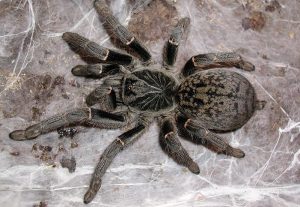Kilimanjaro Mustard Baboon (Pterinochilus chordatus)
Old World, Pterinochilus April 17th, 2016The Kilimanjaro Mustard Baboon Spider is an old world tarantula from the eastern part of Africa and can be found in Tanzania and Sudan. They grow to be about 4 to 5 inches in length with females living to be as old as 20 years old and males living to be about 3 to 5 years old. The true colors of the Kilimanjaro Mustard Baboon is dark grey and black with a thin orange tint at the knees however there is a light color form of this species that is orange/brown and black.
Habitat: As full grown adults the most you will need for the kilimanjaro mustard baboon a 5 gallon enclosure. They are obligate burrowers though do just fine with a startup hide or piece of bark to live under. They are pretty good at webbing. Though not heavy webbers like their distant cousin the OBT. We recommend you give them 5 to 6 inches of damp substrate in the event your baboon does end up burrowing. Temperatures should be kept in the higher 70’s Fahrenheit with humidity levels of about 60 to 65 percent. As slings they do just fine in vials and at 1 inch in size can easily be transferred to deli cups. As always a good water source should always be available in their enclosure whether its a water dish or spraying.
Feeding: These guys are voracious eaters. As slings you can feed them fruitflies and pinhead crickets with their heads smashed in. One of the few species that personally goes out to hunt instead of waiting for you to throw prey towards them. You can feed them a variety of meals such as crickets, roaches, mealworms, superworms and even locusts. Feeding once a week would be ideal.
Attitude: Being old world they come packed with attitude. Though not as fast and aggressive as their cousin the P.murinus. You should still use caution when opening their enclosure to feed or do maintenance. Their bite can bring a world of pain and they have potent venom. Though not lethal it can induce muscle pains, cramps, headaches and nausea. We recommend you to not handle this tarantulas!
All in all a definite beauty to have and most definitely a less aggressive alternative to the OBT if you are planning on getting a good hardy African tarantula.






